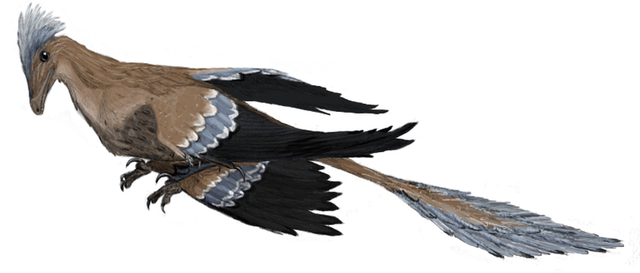
Feathered dinosaurs existed for millions of years before the origin of birds and, for a time, there was a period where feathered dinosaurs and early birds coexisted with animals that don't fit neatly into either category. One of the latter was microraptor, a feathered dinosaur that doesn't appear to have been of the avian lineage but still seems to have had wing-like feathers on all four of its limbs. Researchers have now found that microraptor did have a close relationship with birds: it ate them.
Microraptor, as its name implies, was a small dinosaur, maybe a meter long counting its tail. Based on the number of fossils we've recovered, it was about as unremarkable as a pigeon in its day, which was about 120 million years ago. But most reconstructions suggest it looked rather unusual by modern standards. That's because microraptor featured wing-like forelimbs that retained claws, and hindlimbs that had an array of feathers similar to that on its forelimbs. A number of researchers suggest it could fly or glide, possibly using all four limbs for lift.
There's an obvious visual affinity with birds, but that lineage was already well established by the time microraptor came along. So well established that, when researchers identified a few small bones within the ribcage of a microraptor fossil, they were able to not only identify them as avian, but assign them to a specific group of birds that were common at the time (the enantiornithines).
As the authors of the paper that describes this find note, this sort of thing isn't unprecedented. There's a long list of fossils that died shortly after eating something else, often something that was phylogenetically quite distant. "The first feathered dinosaur Sinosauropteryx often preserves the remains of mammals and lizards in the stomach cavity, a specimen of the mammal Repenomamus preserves the remains of a baby Psittacosaurus dinosaur, the basal ornithurine bird Yanornis preserves fish remains in the stomach of one specimen, and a specimen of the giant compsognathid Sinocalliopteryx was reported to have an incomplete dromaeosaurid leg preserved inside its abdominal cavity," according to the paper. Other birds of the sort eaten here even found their way into the remains of ocean-going reptiles.
That last example was probably a matter of scavenging, since these weren't ocean-going birds. But the authors think that the new microraptor may be a case of intentional consumption. The orientation of the bird's skeletal remains within the dinosaur indicate that it was swallowed whole, and in the orientation normally used by modern predatory birds. Since the bird itself has feet that indicate it was adapted to perching in trees (no telephone wires back then), the authors think this implies that microraptor hunted in the trees.
Another microraptor fossil, however, was found with a mammal bone in its abdomen, so it's not obvious that this bird represents the animal's typical meal. In any case, it's a pretty spectacular find, and does a few new hints about this enigmatic dinosaur's lifestyle.
PNAS, 2011. DOI: 10.1073/pnas.1117727108 (About DOIs).
Listing image by Photograph by Wikimedia Commons
reader comments
63